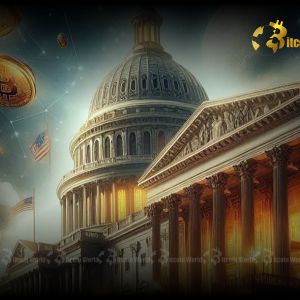Crucial Crypto Bill Stumbles in U.S. House Vote, Second Attempt Looms Amidst Presidential Fury
8 min read
BitcoinWorld Crucial Crypto Bill Stumbles in U.S. House Vote, Second Attempt Looms Amidst Presidential Fury The halls of the U.S. Capitol are buzzing with unexpected drama following a significant setback for cryptocurrency advocates. A pivotal crypto bill , poised to shape the future of digital assets in America, recently failed a crucial procedural vote in the U.S. House of Representatives. This turn of events has not only sent ripples through the legislative chambers but has also reportedly drawn the ire of the President himself, adding a layer of high-stakes political intrigue to the ongoing debate over digital asset policy. The Unexpected Stumble: What Happened with the Crypto Bill? In a surprising development that caught many off guard, the U.S. House of Representatives saw a key crypto bill falter during its initial procedural vote. This vote, often a formality that paves the way for a full debate and final vote on a piece of legislation, instead became a roadblock. According to reports from Fox News, cited by Jin10, the bill failed to garner the necessary support to proceed, putting its immediate future in question. For those unfamiliar with the legislative process, a procedural vote is essentially a vote on the rules or procedures for considering a bill, rather than on the bill’s substance itself. It’s a critical step that dictates how a bill will be debated, amended, and ultimately voted upon. A failure at this stage can indicate significant opposition or strategic maneuvering by lawmakers aiming to block or delay the legislation. Despite this initial setback, there’s still hope for the bill. Plans are already in motion to hold a second vote, reportedly scheduled for around 21:00 UTC. This swift re-attempt underscores the urgency and importance attached to this particular piece of digital asset legislation , suggesting that its proponents are not ready to give up without a fight. The coming hours will be critical in determining whether this legislative effort can overcome its initial hurdle and move forward. Understanding the House Vote Dynamics and Political Fallout The failure of the initial House vote has ignited a firestorm of political activity. The report that the President is ‘angry’ and actively engaging with lawmakers who blocked the bill highlights the high stakes involved. This direct intervention from the executive branch signals the administration’s keen interest in the outcome of this legislation and its potential implications for the broader economy and technological innovation. Why would a procedural vote draw such presidential ire? Often, such failures indicate a lack of party discipline, unexpected bipartisan opposition, or strategic dissent within the President’s own party. It suggests that the administration had anticipated a smoother path for the bill and views its blockage as a significant challenge to its legislative agenda. The President’s engagement with these lawmakers could involve persuasive arguments, political pressure, or even negotiations to secure their support for the upcoming second vote. The dynamics of this House vote are complex. Was it a genuine rejection of the bill’s content, or a tactical move to extract concessions or send a message? The answer likely lies in the specific concerns of the lawmakers who voted against it. These concerns could range from worries about consumer protection, financial stability, or even the competitive landscape for traditional finance. Understanding these underlying motivations is crucial for predicting the outcome of the second vote and the future trajectory of U.S. crypto regulation . Why U.S. Crypto Regulation is a Contentious Battleground The struggle to pass comprehensive U.S. crypto regulation is not new. For years, lawmakers, regulators, and industry stakeholders have grappled with how to effectively oversee the rapidly evolving digital asset space. The inherent novelty and decentralized nature of cryptocurrencies pose unique challenges for traditional regulatory frameworks, which were largely designed for centralized financial systems. The debate often pits proponents of innovation and economic growth against those prioritizing consumer protection, financial stability, and national security. On one side, industry leaders argue for clear, concise rules that foster innovation and allow the U.S. to remain competitive on the global stage. They often advocate for a light-touch approach that avoids stifling technological advancement. On the other side, concerns are frequently raised about illicit finance, market manipulation, and the potential for retail investors to lose money in volatile or fraudulent schemes. Regulators like the SEC and CFTC have often asserted their jurisdiction, leading to a patchwork of enforcement actions rather than a unified regulatory framework. This lack of clarity has created an environment of uncertainty, making it difficult for businesses to operate and innovate within the U.S. The current legislative push, embodied by this crypto bill , aims to bring some much-needed clarity and structure to this chaotic landscape. However, as the recent procedural vote shows, achieving consensus on such a complex and multifaceted issue is an uphill battle, requiring significant political will and compromise from all parties involved. The President’s Stance: A Key Indicator for Digital Asset Legislation? The reported anger of the President is a significant development, underscoring the executive branch’s growing focus on digital assets. Historically, presidential administrations have varied in their approach to cryptocurrency, with some taking a more cautious stance while others have expressed openness to its potential. The current President’s stance appears to be one of urgency and a desire for concrete action, especially given the rapid global adoption of digital currencies. While the specifics of the President’s direct conversations with lawmakers are not public, his involvement suggests that this particular digital asset legislation aligns with his administration’s broader economic or technological goals. It could be that the administration views robust crypto regulation as essential for maintaining U.S. leadership in financial innovation, combating illicit activities, or even addressing concerns about national security in the digital realm. A President’s direct engagement can be a powerful tool in legislative battles. It can rally wavering votes, put pressure on opponents, and signal to the public the importance of a particular policy. Therefore, the President’s reported frustration is not just an emotional reaction but a strategic indicator that the administration is committed to seeing this or similar legislation pass. This commitment could significantly influence future debates and the eventual shape of U.S. crypto regulation . Challenges and Opportunities for Future Digital Asset Legislation The path forward for digital asset legislation in the U.S. is fraught with both challenges and opportunities. On the challenge front, the primary hurdles include: Lack of Consensus: Disagreement among various government agencies (e.g., SEC, CFTC, Treasury) on who should regulate what, leading to regulatory arbitrage and confusion. Technical Complexity: Many lawmakers and regulators still struggle to fully grasp the intricate technical aspects of blockchain and cryptocurrencies, making it difficult to draft effective legislation. Lobbying Efforts: Powerful lobbying groups from both traditional finance and the crypto industry exert significant influence, often pushing for divergent outcomes. Political Polarization: Crypto, like many other issues, can become a victim of partisan divides, hindering bipartisan cooperation. Despite these challenges, opportunities abound. Clear and comprehensive U.S. crypto regulation could: Foster Innovation: Provide legal certainty for startups and established companies, encouraging investment and development in the U.S. Enhance Consumer Protection: Implement safeguards against fraud, scams, and market manipulation, building trust among retail investors. Improve Market Integrity: Establish rules for exchanges, stablecoins, and DeFi, leading to more transparent and robust markets. Strengthen National Security: Enable better tracking and prevention of illicit financial flows through digital assets. Here’s a brief look at the contrasting approaches to crypto regulation: Approach Description Potential Impact on Innovation Potential Impact on Consumer Protection Strict Regulation Heavy oversight, detailed rules, high compliance burden (e.g., EU’s MiCA) May stifle some innovation due to high costs and complexity High, strong safeguards against fraud and market abuse Light-Touch Regulation Minimal rules, focus on existing laws, industry self-regulation (e.g., early U.S. approach) High, encourages rapid development and experimentation Lower, potential for more scams and market instability Innovation-Focused (Sandbox) Regulatory sandboxes for testing, flexible frameworks Moderate to High, allows for controlled experimentation Moderate, specific protections within sandbox environment What Does This Mean for the Crypto Market? The legislative drama surrounding this crypto bill inevitably sends signals to the broader crypto market. In the short term, uncertainty around the second House vote could lead to increased volatility in digital asset prices. Investors and businesses prefer regulatory clarity, and any perceived delay or failure in establishing a clear framework can cause apprehension. However, if the bill eventually passes, it could be a significant positive catalyst. Clear U.S. crypto regulation would likely attract more institutional investment, provide greater legitimacy to digital assets, and enable a wider range of financial products and services. Conversely, a prolonged legislative stalemate or the failure of this bill could push innovation and investment to more crypto-friendly jurisdictions, potentially hindering the U.S.’s position as a global leader in the digital economy. Actionable Insights for Crypto Enthusiasts and Businesses Given the ongoing legislative developments, what can crypto enthusiasts and businesses do? Stay Informed: Keep a close eye on news from Capitol Hill, especially regarding the upcoming second vote and any subsequent legislative efforts. Understanding the nuances of proposed digital asset legislation is key. Engage (where possible): For businesses and advocacy groups, engaging with policymakers, sharing insights, and advocating for sensible regulation can be impactful. Individual enthusiasts can support organizations that champion responsible crypto policies. Understand the Risks: While the promise of crypto is immense, regulatory uncertainty remains a significant risk factor. Diversify portfolios and be aware of the evolving legal landscape. Looking Ahead: The Path for U.S. Crypto Regulation The immediate focus is on the second House vote . Its outcome will determine whether this specific crypto bill proceeds or faces further delays. Even if it passes this procedural hurdle, the bill will still need to navigate through full House and Senate votes, potentially facing amendments and further debate. The legislative process is often long and arduous, especially for groundbreaking areas like digital assets. Regardless of this specific bill’s fate, the broader push for comprehensive U.S. crypto regulation is unlikely to subside. The increasing integration of digital assets into the global financial system necessitates a clear legal framework. The President’s strong reaction indicates a clear desire from the executive branch to see progress. This ongoing legislative journey will undoubtedly shape not just the crypto industry in the U.S. but also influence global standards for digital asset governance. The initial stumble of the crypto bill in the U.S. House of Representatives serves as a stark reminder of the complexities and political hurdles involved in shaping the future of digital assets. While the immediate outcome of the second House vote remains to be seen, the reported anger of the President underscores the high stakes and the administration’s commitment to advancing U.S. crypto regulation . This ongoing legislative battle is more than just a procedural vote; it’s a critical moment that will define the landscape for digital asset legislation , impacting innovation, consumer protection, and America’s role in the global digital economy. The world watches as lawmakers decide the next chapter for crypto in the U.S. To learn more about the latest crypto market trends , explore our articles on key developments shaping U.S. crypto regulation and its impact on digital asset adoption . This post Crucial Crypto Bill Stumbles in U.S. House Vote, Second Attempt Looms Amidst Presidential Fury first appeared on BitcoinWorld and is written by Editorial Team

Source: Bitcoin World



